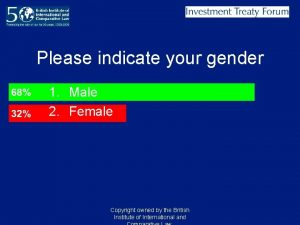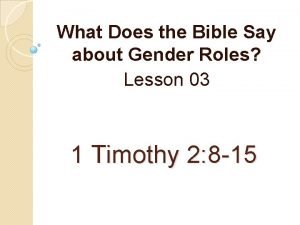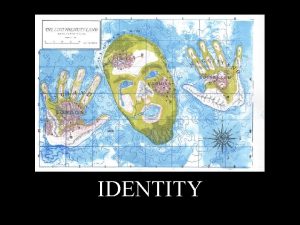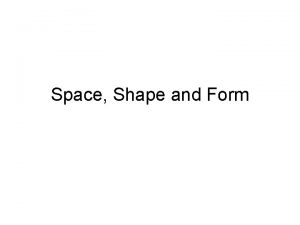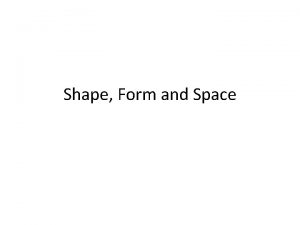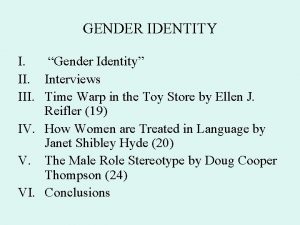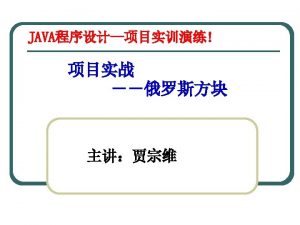GENDER AND IDENTITY HOW DOES GENDER SHAPE YOUR














- Slides: 14

GENDER AND IDENTITY HOW DOES GENDER SHAPE YOUR IDENTITY? http: //www. youtube. com/watch? v=g. MYm. IXuh. Tvo http: //www. youtube. com/watch? v=Vqsbv. G 40 Ww&feature=related

LEARNING OBJECTIVES �Explain how gender influences a person’s identity. �Be able to evaluate the notion that gender identities have been socially constructed.

SEX AND GENDER – WHAT IS THE DIFFERENCE? SEX GENDER �Biological differences between males and females. �Chromosomes, hormones, menstruation and genitalia. �Cultural expectations. �Each gender is expected to conform to masculine and feminine behaviour. �These concepts are not fixed; they change over time and differ from culture to culture.

BIOLOGY V CULTURE �What evidence do the Sociobiologists use to explain the differences between the sexes? �What evidence does the feminist Ann Oakly use to counter-argue the biological arguement?

GENDER STEREOTYPES • Men are: strong, rational, tough, business- minded, capable, logical. • Women are: passive, gentle, caring, emotional, dizzy, maternal.

GENDER STEREOTYPES - DISNEY http: //www. youtube. com/watch? v=B 8 O 8 p 0 Ac 1 Rg

GENDER ROLE SOCIALISATION �Gender differences between males and females are largely the result of society’s expectations. �Masculinity and Femininity are SOCIALLY CONSTRUCTED rather than being the product of biology.

HEGEMONY �Connell (2002) – hegemonic masculinity and femininity dominated our culture until recently. �Distinct maternal and paternal family roles.

PROCESSES TO THE CONSTRUCTION OF GENDER IDENTITY. �MANIPULATION – encourage and reward sex appropriate behaviour. �CANALIZATION – directed towards appropriate toys �DOMESTIC ACTIVITIES �VERBAL APPELLATIONS

GENDER CODES �Statham (1986) – by the age of 5, most children have acquired a clear identity.

THE EDUCATION SYSTEM AND TRADITIONAL GENDER ROLE SOCIALISATION �Sue Sharpe – study of working class girls in the 1970’s –found that girls education was regarded as less important than boys. �Early feminist studies in the 1970’s

CRITICISMS OF GENDER ROLE SOCIALISATION �Are the experiences of all �Are we so passive that men and women the we accept the gender same? Do they differ roles imposed upon us? according to age, ethnicity, class?

How is it done? �Examples of role modelling, imitation and sanctions in �Primary agents �Secondary agents �http: //www. youtube. com/ watch? v=j. Ccio 8 Kd. Wf. M �http: //www. youtube. com/ watch? v=ebno 9 Rt 0 be. U �http: //www. youtube. com/ watch? v=V 8 gp. HK 5 or. JQ �

Activity in workbooks �How do agents of socialisation affect gender identity? �Family �Education �Media �Religion �Peer group �Media
 Your conscious awareness of your own name
Your conscious awareness of your own name Strategic gender needs and practical gender needs
Strategic gender needs and practical gender needs Gender roles and identity
Gender roles and identity Sexual orientation gender identity
Sexual orientation gender identity Gender identity
Gender identity Gender identity tagalog
Gender identity tagalog Examples of identities of a person
Examples of identities of a person Shape matching and object recognition using shape contexts
Shape matching and object recognition using shape contexts Shape matching and object recognition using shape contexts
Shape matching and object recognition using shape contexts Cessna airfoil
Cessna airfoil Give us your hungry your tired your poor
Give us your hungry your tired your poor Does your walk match your talk
Does your walk match your talk Indicate your gender
Indicate your gender What does the bible say about gender roles
What does the bible say about gender roles Factors affecting optimum weight
Factors affecting optimum weight












